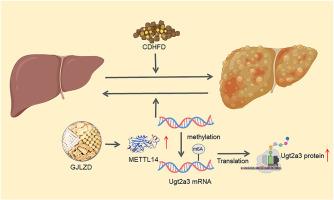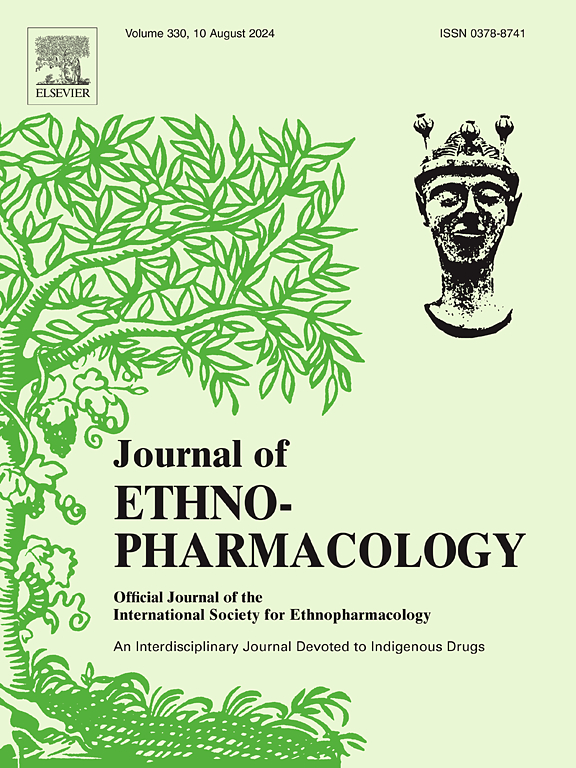Gan-Jiang-Ling-Zhu decoction improves steatohepatitis induced by choline-deficient-high-fat-diet through the METTL14/N6-methyladenosine-mediated Ugt2a3 expression
IF 4.8
2区 医学
Q1 CHEMISTRY, MEDICINAL
引用次数: 0
Abstract
Ethnopharmacological relevance
Gan-Jiang-Ling-Zhu (GJLZ) decoction, a classical Chinese herbal prescription, can be applied for the treatment of metabolic diseases including liver steatosis. Although GJLZ decoction has been widely applied clinically for thousands of years, the mechanism of GJLZ decoction behind treatment of nonalcoholic steatohepatitis (NASH) remains relatively unelucidated.
Aim of the study
To elucidate the efficacy of GJLZ decoction in the treatment of NASH and to investigate its underlying mechanisms from an epigenetic perspective.
Materials and methods
The quality control of chemical components in GJLZ decoction was conducted. C57BL/6J mice with NASH were induced by feeding them a choline-deficient-high-fat-diet (CDHFD), along with GJLZ decoction intervention for 4 weeks. Then NASH phenotypes including histological steatosis, inflammation, hepatic apoptosis, fibrosis, serum liver enzyme and lipid level were measured. N6-methyladenosine (m6A) and transcriptome sequencing were performed. Levels and functions of methyltransferases and different genes were performed by quantitative polymerase chain reaction, immunofluorescence, gene knockdown, oil red O staining and western blotting.
Results
GJLZ decoction significantly reduced liver weight, liver index and improved hepatic steatosis, and inflammation, as well as inhibited hepatic apoptosis and fibrosis. Moreover, GJLZ decoction significantly reduced the levels of lactate dehydrogenase, aminotransferase, triglyceride, aspartate aminotransferase, and inhibited levels of interleukin 6 and tumor necrosis factor α. Transcriptome and m6A sequencing revealed the landscape of transcriptome and m6A modification influenced by NASH and the following GJLZ decoction intervention. Eleven differential genes were identified, and GJLZ markedly promoted m6A level of UDP glucuronosyltransferase family 2 member A3 (Ugt2a3), to promote its expression. Additionally, GJLZ significantly promoted methyltransferase 14 (METTL14) expression, whereas METTL14 knockdown aggravated hepatocellular steatosis. Finally, METTL14 knockdown significantly reduced the level of Ugt2a3 by promoting its degradation, whereas, Ugt2a3 overexpression could markedly inhibit hepatocellular steatosis.
Conclusions
GJLZ decoction demonstrates potential in alleviating CDHFD-induced NASH by modulating the METTL14-m6A-Ugt2a3 axis, offering a novel therapeutic approach for NASH treatment.

赣江菱角煎剂通过METTL14/N6-甲基腺苷介导的Ugt2a3表达改善胆碱缺失-高脂饮食诱导的脂肪性肝炎
民族药理学意义:甘姜灵芝煎剂是一种经典的中药处方,可用于治疗包括肝脏脂肪变性在内的代谢性疾病。尽管甘姜灵芝煎剂已在临床上广泛应用了数千年,但甘姜灵芝煎剂治疗非酒精性脂肪性肝炎(NASH)的机制仍相对不明确:研究目的:阐明GJLZ煎剂治疗NASH的疗效,并从表观遗传学的角度研究其潜在机制:对GJLZ煎剂中的化学成分进行质量控制。用胆碱缺陷-高脂饮食(CDHFD)诱导C57BL/6J小鼠患NASH,同时用GJLZ煎剂干预4周。然后测定NASH表型,包括组织学脂肪变性、炎症、肝细胞凋亡、纤维化、血清肝酶和血脂水平。进行了N6-甲基腺苷(m6A)和转录组测序。通过定量聚合酶链式反应、免疫荧光、基因敲除、油红 O 染色和 Western 印迹等方法检测甲基转移酶和不同基因的水平和功能:结果:GJLZ水煎剂能明显降低肝脏重量和肝脏指数,改善肝脏脂肪变性和炎症,抑制肝细胞凋亡和肝纤维化。此外,GJLZ煎剂还能明显降低乳酸脱氢酶、氨基转移酶、甘油三酯、天门冬氨酸氨基转移酶的水平,抑制白细胞介素6和肿瘤坏死因子α的水平。 转录组和m6A测序揭示了NASH和GJLZ煎剂干预后转录组和m6A修饰的变化情况。GJLZ明显促进了UDP葡萄糖醛酸转移酶家族2成员A3(Ugt2a3)的m6A水平,从而促进了其表达。此外,GJLZ 能显著促进甲基转移酶 14(METTL14)的表达,而敲除 METTL14 会加重肝细胞脂肪变性。最后,METTL14敲除会促进Ugt2a3的降解,从而显著降低Ugt2a3的水平,而Ugt2a3过表达则能明显抑制肝细胞脂肪变性:结论:GJLZ水煎剂通过调节METTL14-m6A-Ugt2a3轴,具有缓解CDHFD诱导的NASH的潜力,为治疗NASH提供了一种新的治疗方法。
本文章由计算机程序翻译,如有差异,请以英文原文为准。
求助全文
约1分钟内获得全文
求助全文
来源期刊

Journal of ethnopharmacology
医学-全科医学与补充医学
CiteScore
10.30
自引率
5.60%
发文量
967
审稿时长
77 days
期刊介绍:
The Journal of Ethnopharmacology is dedicated to the exchange of information and understandings about people''s use of plants, fungi, animals, microorganisms and minerals and their biological and pharmacological effects based on the principles established through international conventions. Early people confronted with illness and disease, discovered a wealth of useful therapeutic agents in the plant and animal kingdoms. The empirical knowledge of these medicinal substances and their toxic potential was passed on by oral tradition and sometimes recorded in herbals and other texts on materia medica. Many valuable drugs of today (e.g., atropine, ephedrine, tubocurarine, digoxin, reserpine) came into use through the study of indigenous remedies. Chemists continue to use plant-derived drugs (e.g., morphine, taxol, physostigmine, quinidine, emetine) as prototypes in their attempts to develop more effective and less toxic medicinals.
 求助内容:
求助内容: 应助结果提醒方式:
应助结果提醒方式:


